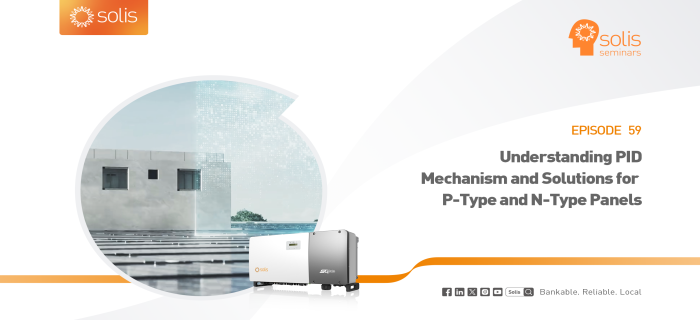
Solis Seminar ?Episode 59?: Understanding PID Mechanism and Solutions for P-Type and N-Type Panels
13 Feb 2024
Background:
Potential Induced Degradation (PID) significantly impacts the long-term stability and reliability of photovoltaic modules. Addressing PID involves understanding its causes and implementing effective solutions. This Solis seminar delves into the PID mechanisms specific to P-type and N-type photovoltaic panels, offering insights into protection methods.
Main Causes of PID
Leakage Current Phenomenon:
Poor insulation in PV panels leads to leakage current, especially in humid environments, causing water vapor infiltration. Chemical reactions involving EVA film, glass, and water vapor produce Na+, resulting in PID under the influence of an applied electric field.
High system voltage:
Typically, the open circuit voltage of a single PV series is around 1000V, the working voltage is approximately 800V. The aluminum alloy frame of the component needs lightning protection and grounding. This configuration creates a significant DC high voltage between the battery and the aluminum frame. Consequently, a voltage bias develops between the PV cell and the metal grounding frame, giving rise to potential induction.
PV module PID main type
P-type module PID effect characteristics (BIFACIAL DUAL GLASS MODULE
PID mechanism of P-type PERC double-sided PV module
As shown in the figure, for P-type double-sided double-glass components, the front is generally PID-s, the back is generally PID-p, and PID-c may occur; Due to the consideration of lightning protection and grounding of the PV module frame, negative bias is formed between the panel and the frame. At this time, the border is positively charged, and the Na+ in the front glass will migrate and gather in the adhesive film layer on the surface of the battery, and diffuse and fill the defect of the silicon crystal, passing through the PN junction, thus forming the leakage current channel at both ends of the PN junction.
Due to negative bias, Na+ in the back glass rapidly gathers to the adhesive film layer on the back of the battery, attracting the electrons on the back and the original passivation layer with negative charge, resulting in deterioration of the passivation effect, resulting in PID-p attenuation. And the closer to the negative output panel, the greater the negative bias, the more obvious the PID failure.
P-type module PID effect characteristics (BIFACIAL DUAL GLASS MODULE)
As shown in the figure, for N-type batteries, the front is usually PID-s and PID-p attenuation, and the back is generally PID-s attenuation; The front is similar to the P-panel application, with negative bias between the panel and the bezel. Na+ in the front glass accumulates on the surface of the battery. On the one hand, Na+ passes through the PN junction to form a leakage current channel, resulting in PID-s. On the other hand, the negative electrons of the passivation layer are attracted by Na+, which leads to the deterioration of passivation effect, resulting in PID-p phenomenon.
Compared with P-type PV module, the positive carrier of N-type PV module is electron, which will have greater PID-s loss, and the loss is more serious than that on the back. Due to the negative bias on the back side, Na+ in the back glass rapidly gathers to the adhesive film layer on the back of the battery, passes through the PN junction, and forms a leakage current channel, resulting in PID-s attenuation.
Based on the above analysis, the inducement of PID effect produced by N-type or P-type PV module is consistent, and only PID types are distinguished in different planes, so the protection methods are the same, mainly as follows:
Negative Direct Grounding Solution:
Grounding the negative electrode of the PV module or inverter through a resistor or fuse ensures that the negative voltage of the module and the grounding metal frame maintain equal potential. This solution is predominantly employed in centralized inverters, as illustrated in the figure.
Note: This solution is limited to the use of isolated inverters. Non-isolated photovoltaic inverters require additional isolation transformers, incurring relatively higher costs with lower safety levels.
Virtual Neutral Grounding Solution:
Ideal for large-scale photovoltaic power stations consisting of string photovoltaic inverters and centralized inverters. Elevating the potential of the virtual neutral point brings the negative PV string voltage close to zero potential, effectively achieving PID suppression.
Note: While suitable for PID protection in new projects, this solution cannot repair PV systems affected by PID. It does not offer point-to-point protection, and equipment failures may affect the module protection of the entire PV subarray.
Forward Bias Voltage Solution:
Utilizing the internal or external PID module of the inverter, a positive bias voltage is applied to the positive and negative electrodes of the PV string to repair the PID effect. This solution offers various output modes.
Current Practice: The prevailing approach involves the use of built-in anti-PID technology, mainly in Solis inverters. This technology facilitates string-level PID repair within the inverter unit, enhancing the accuracy and reliability of the repair process. Notably, this approach eliminates the need for transformer access.
In conclusion, employing these uniform PID solutions ensures the efficient operation and longevity of both N-type and P-type PV modules. Solis inverters, equipped with built-in PID repair modules, represent a contemporary and reliable choice for optimizing photovoltaic system performance.


leave your comment